
Eumorpha pandorus, the Pandora sphinx moth or Pandorus sphinx moth, is a North American moth in the family Sphingidae. The species was first described by Jacob Hübner in 1821.

Cocytius antaeus, the giant sphinx, is a moth of the family Sphingidae. The species was first described by Dru Drury in 1773.

Sphinx chersis, the great ash sphinx or northern ash sphinx, is a moth that belongs to the family Sphingidae.

Lintneria eremitus, the hermit sphinx, is a moth of the family Sphingidae. The species was first described by Jacob Hübner in 1823. It is found in the temperate areas of the eastern United States, north into southern Canada over the Great Plains. It prefers gardens and yards, but is common wherever the nectar and larval host plants are found. This moth is easily confused with the Canadian sphinx but these two moths do not typically co-occur.

Eumorpha is a genus of moths in the family Sphingidae. The genus is mostly found in North and South America.

Smerinthus jamaicensis, the twin-spotted sphinx, is a moth of the family Sphingidae. The species was first described by Dru Drury in 1773.
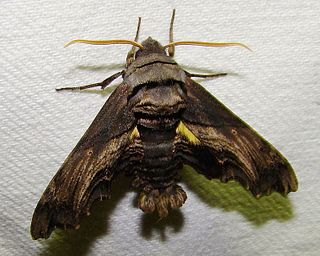
Sphecodina abbottii, or Abbott's sphinx, is a moth of the family Sphingidae. The species was first described by William John Swainson in 1821.

Pachylia ficus, known as the fig sphinx, is a moth of the family Sphingidae. It lives from the northern tip of South America in Uruguay through Central America to the southern tip of the United States straying into Arizona and Texas.

Eumorpha anchemolus, the anchemola sphinx moth, is a moth of the family Sphingidae. The species was first described by Pieter Cramer in 1780.

Eumorpha intermedia, the intermediate sphinx, is a moth of the family Sphingidae. The species was first described by Benjamin Preston Clark in 1917. It lives in the US states of North Carolina, Florida, Mississippi, Louisiana, and southern Texas.

Eumorpha phorbas is a moth of the family Sphingidae.

Eumorpha typhon, the Typhon sphinx, is a moth of the family Sphingidae. The species was first described by Johann Christoph Friedrich Klug in 1836.

Eumorpha vitis, known as the vine sphinx, is a moth of the family Sphingidae.

Hemaris thysbe, the hummingbird clearwing, is a moth of the family Sphingidae (hawkmoths). Coloration varies between individuals, but typically the moth is olive green and burgundy on its back, and white or yellow and burgundy on the underside. Its wings are transparent with a reddish-brown border. It has light-colored legs, which combined with the lack of striping on the underside is diagnostic. Beating its wings rapidly, H. thysbe hovers to collect nectar from a variety of flowers. The combination of its appearance and its behavior commonly leads to it being confused with a hummingbird or bumblebee.

Theretra clotho, the common hunter hawkmoth, is a moth of the family Sphingidae. It is found from Sri Lanka, India, Nepal and Myanmar, east through China to Taiwan, South Korea and Japan, and then south-east through South East Asia as far as the Lesser Sunda Islands and Timor in Indonesia. They can disperse long distances and may be found up to northern China. The habitat consists of open forests, forest edges, orchards, plantations, wooded scrubs, suburban gardens and city parks.
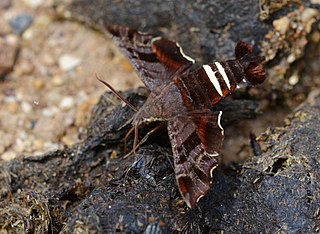
Amphion floridensis, the Nessus sphinx, is a day-flying moth of the family Sphingidae. The species was described by Pieter Cramer in 1777, and renamed in 1920. It is the only member of the genus Amphion erected by Jacob Hübner in 1819. It lives throughout the eastern United States and Canada and occasionally south into Mexico, and is one of the more commonly encountered day-flying moths in the region, easily recognized by the two bright-yellow bands across the abdomen.
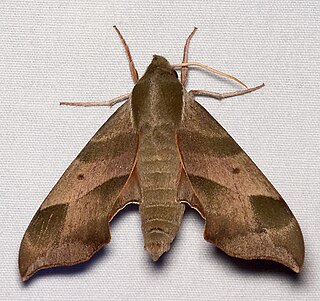
Darapsa myron, the Virginia creeper sphinx, is a moth of the family Sphingidae found in central and eastern North America.

Aellopos tantalus, known as the Tantalus sphinx, is a moth of the family Sphingidae. It is found in Florida, the Antilles, from Mexico to Venezuela, Colombia, Ecuador, Suriname, and in the Amazon basin.
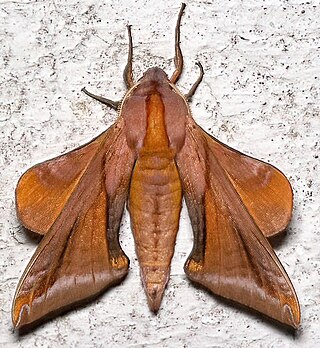
Paonias astylus, the huckleberry sphinx, is a moth in the family Sphingidae. The species was first described by Dru Drury in 1773.
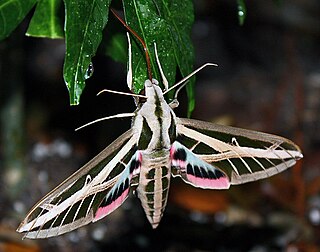
Eumorpha fasciatus, the banded sphinx, is a moth of the family Sphingidae. The species was first described by Johann Heinrich Sulzer in 1776.























